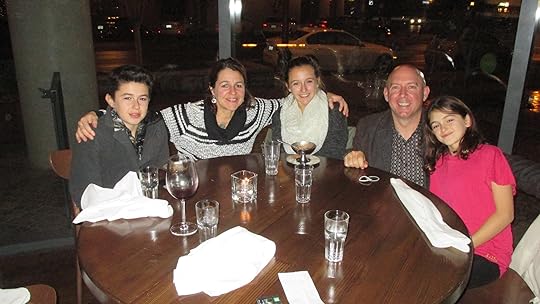Dan Pontefract's Blog, page 32
February 6, 2016
If There Is No Trust Or Joy At Work There Is A Low Chance For Purpose
The day after delivering a keynote presentation, I received an email from Candice who kindly agreed to share her story. She wrote:
Dear Dan,
I was at the conference you spoke at yesterday; I have to say it inspired me. I wanted to take a moment to say, “Thank You!” I am data analyst within a federal organization and have recently accepted a one-year developmental opportunity within our IT department.
Let me give you some background. I am your stereotypical HR employee. I smile, I laugh, I bring in baked goods, I overuse words like awesome and fantastic and I definitely use way too many emoticons when sending out e-mails.
I love providing feedback and telling people what a great job they are doing.
In October I started working in IT and found it the exact opposite of HR (no big surprise). If I didn’t get up and walk around to say, “Hi,” I could go days without seeing my colleagues. We communicate strictly over e-mail (for “racking purposes”). It is stifling and it does not encourage collaboration or innovation. Which is (what I originally thought) IT was all about.
YES, bring down the walls and have us all work together. Let’s talk, brainstorm and bring all of our ideas to the table. Let’s stop being disengaged and become engaged in the work and each other.
Even as a “worker-bee” in our organization I know I can influence change.
Candice wasn’t necessarily asking for help, but I felt compelled to respond and to offer what I could. Part of my response to Candice was as follows:
Hey Candice,
Thank you so much for reaching out. What an honor for you to feel so trusting as to share such an intimate and heartfelt story. I applaud you. Many don’t have the courage to send that first email.
I suppose I’m glad my talk struck a nerve. Hopefully one of two things happens for you next:
1. You can affect change within your department so your fellow colleagues are more like humans and more collaborative
2. You self-analyze that (perhaps) they can’t be changed, and you set a course for a new place to call your work home
That said, I think IT needs more people like you to help shift the heads down, let’s-not-talk-about-it culture.
Yes, an emoticon. Hang in there.
Cheers
dp
 With gratitude and more emoticons, Candice responded by thanking me for taking the time to provide a few workplace options for her to consider. Perhaps my decision to engage in unsolicited career advice with Candice was due in part to Alfred Adler.
With gratitude and more emoticons, Candice responded by thanking me for taking the time to provide a few workplace options for her to consider. Perhaps my decision to engage in unsolicited career advice with Candice was due in part to Alfred Adler.
In the late 1800s, as a psychiatrist in Vienna, he was the first researcher of a more connected and humanistic philosophy of living. Among other characteristics and theories regarding optimal human development, Adler believed each individual was born creative, determined and unique. He also believed people were oozing with social tendencies possessing the capacity to live in harmony and with a penchant for community.
Adler suggested humans would not only push for their own self-development, they would contribute to the well-being and purpose of others. When I discovered his writings and research several moons ago, his way of thinking (and his way of being) struck a nerve. Adler’s theories and thinking — and his views on psychology — may explain why he left Sigmund Freud’s inner Vienna circle back in the early 1900s.
Freudism and Adlerism are rather different psychologies. For me, Adler’s work has a profound impact on the way in which I choose to engage with others and the way I choose to live my life. It’s helped me understand why some leaders are better at developing others as well.
In Candice’s situation, there were three rhetorical questions to ask:
Where was her leader in a time of need?
What was the culture like on her team, or the organization?
Why wasn’t the leader developing a culture that permitted Candice to demonstrate purpose in her role at work?
Paul J. Zak, a neuroeconomist at Claremont Graduate University and author of The Moral Molecule developed a theory known as Ofactor. It’s a theory of organizational design that suggests an employee’s level of joy has a causal and direct relationship to both trust and purpose.
In simpler terms, “Trust multiplied by Purpose = Joy.” Interestingly, the “O” of Ofactor pays homage to oxytocin, what Zak believes (and proves through his research) is the chemical foundation for trusting others.
With respect to leaders, he writes:
Trust can be raised by implementing policies explicitly designed to empower and engage employees. When managers implement policies that raise trust, colleagues at work have the incentives and resources to perform better, boosting organizational performance.
It seemed to me that Candice’s lack of joy led to disenchantment. Consequently, she became disengaged and her levels of trust waned if not disappeared. Zak’s research suggests an environment without trust (and arguably workplace purpose) will cause a lack of joy. For Candice, a workplace without joy was akin to a bee hive without the honey.
In another study, authors Emily Lawson and Colin Price argued in McKinsey Quarterly that leaders ought to possess an apt level of understanding with both behavioral psychology and neuroscience in order to manage organizational change successfully. Any triumph an organization wants to achieve with respect to change stems from leaders successfully persuading employees to get on board with the change itself and to think differently about their jobs and roles.
Let’s flip Lawson and Price’s theory around for a moment. How might leaders think differently with respect to employee career development, so that workplace situations — such as what Candice was experiencing — simply disappear? The authors state:
Since the collective culture of an organization, strictly speaking, is an aggregate of what is common to all of its group and individual mind-sets, such a transformation entails changing the minds of hundreds or thousands of people.
Indeed, this is what we require in leadership today.
If we want employees, like Candice, to find purpose in their place of work and to be both thriving and innovative, one of the mindset changes that is required of leaders is to recognize the importance of trust, joy and proper career development … in order to aid an employee’s level of workplace engagement.
Candice was arguably on the wrong side of hope. Things were going backwards. One might even suggest she was in a state of cognitive dissonance. She was trying to will her way to some form of career enlightenment without the support of her direct manager and the organization itself.
Established by Leon Festinger in 1957, cognitive dissonance refers to a human being’s quest to achieve internal balance, harmony and consistency. Each of these traits is what each of us should be striving for in a world replete with mobile device addiction, attention deficit disorder and countless – sometimes mindless – management requests. This was precisely what Candice was trying to sort out for herself. Candice was striving for purpose in her role at work.
Festinger argues there are three basic assumptions to cognitive dissonance:
People are sensitive to inconsistencies in their life as it relates to their actions and beliefs
When inconsistency occurs, people take action to try and resolve such dissonance or inconsistency
People will attempt to resolve any inconsistencies by changing their beliefs, actions or the actual perceptions with any new action
Without purpose, trust or joy in an employee’s place of work—without leaders being capable of changing their own mindset to adapt to the career needs of those who work for them, and with the potential for cognitive dissonance—it’s no wonder levels of employee engagement and career fulfillment remain pathetically low.
There are stories like Candice littered throughout the world.
In fact, Kalixa Pro, a U.K.-based firm, found in 2014 that 49% of workers were so unhappy with their place of work that they believed their career choice was a mistake. An additional 24% were so disillusioned that they admitted to describing themselves as poor employees.
Candice deserved a follow-up. I wanted to see if things were progressing. I was interested to see if her career situation had improved such that the dream of workplace joy was somewhere on the horizon. I contacted her again to see if her environment was getting better. Her response was as follows:
Hi Dan,
I took your advice to heart. I have been working hard at creating a more collaborative work environment within my IT team. It has been challenging, but when I catch a colleague smiling, laughing or (gasp) taking me up on my offer of going for coffee, it brings me joy! There is still a long way to go, but every journey starts with small steps.
That being said, I have been actively looking for a way to get back into the HR world. As much as I enjoy learning about systems and using an analytical approach to solving client issues, I feel that my heart belongs to HR.
Last week I was presented with an opportunity to go back to HR in the capacity of an Electronic Performance Support (EPS) designer. It will bring together my two passions, HR and IT systems, as I will be creating EPS solutions for our IT systems and its users!
Thanks again for your advice and being a sounding board. I am glad I took a chance in reaching out to you. You have made a difference!
Everyone deserves a workplace that makes us feel fulfilled, useful and full of purpose. Everyone deserves joy. Candice even remarked, “It brings me joy.” The key to this story with Candice is it’s a two-way street of responsibility, between the leader (who can help shape both the culture and purpose mindset of the team or organization) and the team member, who must take ownership with personal and professional changes required to achieve such a scenario. This is the magic dust intersection of what I refer to as the “sweet spot”.
I may have provided a slight nudge to Candice, but it was nothing more. The good news is that the impetus was already within Candice to make the change, both emotionally and physically. She deserves the kudos. She may not have found herself in such a scenario, however, if the guidance, support and action had been applied earlier by her direct leader. If her organization was one demonstrating the tenets of a more purpose-driven one, perhaps this scenario becomes moot and never happens.
I responded with one final email:
Dear Candice,
Congratulations! This warmed my heart like an out-of-the-oven apple pie does to my tastebuds in the fall. What a fabulous story.
I played a very small part, my dear. You had the courage baked within you from the get-go. Once you used some of those courage reserves, well, look out HR.
All the best.
Cheers
dp
Leaders might view the story of Candice and use it as an opportunity to self-reflect.
Think, for a moment, about those employees who are currently on your team and how you might improve the identification of traits similar to Candice.
What might you do differently in the future to support their development toward a more fruitful and thriving role?
How might you play a part in an employee’s path toward a role that is full of purpose, one that permits the employee to flourish?
How might you shift the culture and operating practices of your organization such that employees are emotionally attached — oozing joy and trust — to the overarching mission of the organization itself?
How might you change the purpose of the organization from one focused solely on maximizing shareholder value and profits, to one that balances both purpose and profit while delighting the customer and other stakeholders?
The purpose of the organization is to delight customers through engaged and empowered employees, acting ethically within society to deliver just profitability that benefits all stakeholders including the community, workers and owners.
We might argue this is what Candice was seeking as well.
In Donald Polkinghorne’s book, Practice and the Human Sciences: The Case for a Judgment-Based Practice of Care, he states:
The accumulation of experiences over time creates a fund to guide future actions. Involved in self-organizations, people are continuously engaged in interaction with their environments – their cultures, physical objects, other persons, and themselves. They are not simply passive recipients of environmental stimuli (or information). Rather, they attend to and affect the world, which in turn affects and evokes changes in them. Apropos of this, two adages express the same truth metaphorically: The burnt child fears the fire and once burned, twice shy. Thus, having learned from experience, a person responds to identical or similar situations differently at different times in his or her life.
Leaders ought to respond differently in a position of authority.
Be both a coach and a strategic visionary of workplace purpose. Assist your team members as they perform in their roles. This can only help to unleash the raw power of purpose.
__________
Dan Pontefract’s next book, THE PURPOSE EFFECT: Building Meaning in Yourself, Your Role and Your Organization, will publish May 10, 2016. He is Chief Envisioner of TELUS Transformation Office.
Dan's Related Posts:Defining A Leader’s Duty Of CareIn Answer To Your Questions About FLAT ARMYMy TEDx Talk on The Purpose EffectThe Simple Act of TrustingMy Definition of Work and an Update on Book Two
January 27, 2016
Defining A Leader’s Duty Of Care
To have purpose in one’s work is to achieve what we might coin “workplace actualization”.
You may be familiar with Abraham Maslow’s “Hierarchy of Needs,” where at the top of society’s (arguably) most famous triangle rests the level known as self-actualization. Maslow depicted the hierarchy of needs in 1943 in a paper titled, “A Theory of Human Motivation.”
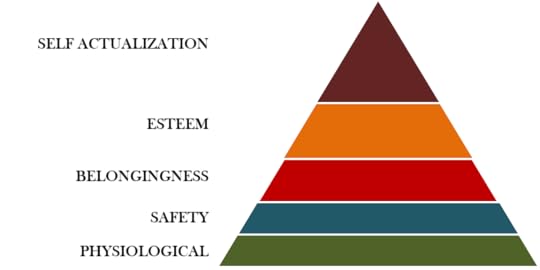
As a reminder, the model is made up of five hierarchical levels (physiological, safety, belongingness, esteem and self-actualization) and can be thought of as therapeutic orthodoxy for a human’s arrival at creativity, spontaneity, morality and a lack of prejudice.
Maslow once stated that business leaders “can set up the conditions so that peak experiences are more likely, or one can perversely set up the conditions so that they are less likely.” His quote is a potential indictment on today’s organization and particularly its leaders who fail to help deliver a purposeful organization and equally important, a purposeful employee mindset.
We might argue that far too many leaders and employees remain stuck at the physiological and safety level equivalent of a “workplace hierarchy of needs” framework.
Before going further, I would also like to suggest that employees will depict one of three types of workplace mindsets in their roles; job, career or purpose.
Job mindset: Performing transactional duties in return for compensation and not much else.
Career mindset: Focused on increasing one’s career girth by advancing salary, title, power, team size and/or span of control.
Purpose mindset: Passionate, innovative and committed to a meaningful and engaging workplace that serves and benefits all stakeholders.
An individual’s mindset when working, therefore, is the result of whether their personal purpose is in alignment with the organization’s purpose, as well as with the duties required to perform in the role itself. Often a job or career mindset is a result of misalignment between personal, organizational and role purpose.
Furthermore, a job or career mindset is the result of a leader failing to demonstrate a duty of care in the employees he ought to be leading.
If we plotted the job, career and purpose mindsets against Maslow’s model, we would discover leaders spending far too much time on the physiological and safety levels and spending less time on the top three. This can have detrimental effects to an employee’s chance for purpose at work.
Should time at the first two levels be expunged? Absolutely not.
Physiological and safety level equivalents of Maslow’s framework inside the workplace consists of such elements as well-being, collegial work setting, fair remuneration, reasonable benefits, properly defined role descriptions, and of course a safe environment. Each of these is important and necessary. Failing to provide these aspects is a failure to deliver a purposeful organization.
But in my experience, far too many leaders stop at the physiological and safety levels. This is a potential reason why so many employees are either disengaged or not engaged at work. It is this author’s opinion that it is the very reason far too many employees do not demonstrate purpose in their work.
Aaron Hurst is the author of The Purpose Economy, and CEO of Imperative. The firm recently released compelling research that suggests “28% of the 150 million-member U.S. workforce defines the role of work in their lives primarily as a source of personal fulfillment and a way to help others.”
In other words, 72% of U.S. based workers do not possess a sense of purpose in their roles at work.
“When employees bring purpose to their work,” Aaron said to me, “they have stronger relationships, feel they make a greater impact and they also report that they are more likely to grow as people.” Aaron believes from his research, analysis and writing that these outcomes are all connected to increased quality of life and lifespan. “It isn’t enough to get purpose outside of work, we need it in the activity in which we spend the majority of our waking hours,” he suggested.
The following diagram illustrates the imbalance that has manifested inside today’s firms.
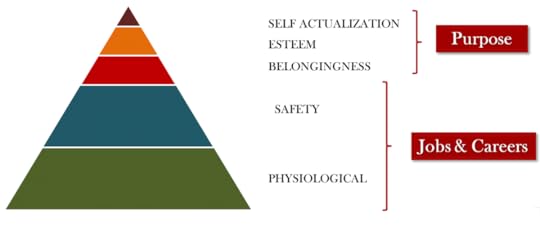
For purpose to be achieved in the organization and by its employees, far more time ought to be spent by leaders (and the organization itself) helping its employees develop belongingness, esteem and self-actualization.
To achieve purpose in one’s role at work, an employee will ultimately need the backing of her direct supervisor. Therefore, the leader ought to exhibit what I refer to as a “duty of care” for the purpose mindset to manifest in the employee. At its root, a duty of care is the leader’s responsibility to help an employee reach workplace actualization.
In the report issued by Imperative, it analyzed workers in several different verticals. One particular vertical caught my eye: retail/wholesale.
If you thought 28% was a low number as the average number across all verticals, you are correct. It is.
But when you drill down into Imperative’s data, you will discover that the lowest vertical is the retail/wholesale industry.
Rather remarkably, there is not much role-based purpose happening in these roles, or for these employees in this vertical.
The report indicated that only 16% of employees in the retail/wholesale vertical possess a sense of purpose in their roles–16%!
We might argue that a duty of care is close to being non-existent for these employees, and their leaders.
Aaron was quick to point out an example.
“There are some companies doing amazing work in retail from the likes of Apple to REI to West Elm,” he said. “They encourage relationships at work, help employees have autonomy and really help employees—and push them—to grow as people at work.”
He cemented my hypothesis for the duty of care theory by indicating:
“Most retail jobs are designed for robots. They lack autonomy and are highly structured. This makes it less attractive for employees to become purpose-oriented people.”
I believe if leaders were to examine Maslow’s Hierarchy of Needs, and were able to look at it as their “duty” to help employees achieve “workplace actualization”—through the graduation from job or career mindsets to a purpose mindset—there might be more purpose-oriented and engaged employees in today’s workforce. Should retail or wholesale employees be made to feel any less in their roles at work?
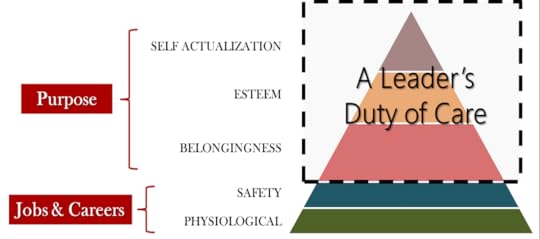
A duty of care is a leader’s responsibility to assist employees with networking, relationship building and introductions to colleagues, partners and customers. When an employee feels as though they ‘belong’ at work, they are far more likely to develop purpose in their work.
A duty of care also includes the establishment and enactment of other attributes such as autonomy, trust, being collaborative, relatedness, independence, balance and clarity for esteem and eventual workplace-actualization to be achieved. A duty of care can help unleash an employee’s passion and creativity which then ideally unites them with a greater sense of purpose in their work, perfectly aligned to the newly defined purpose of the organization.
I asked Aaron one last question. What would happen if the 28% average figure of purpose-oriented employees were to dramatically increase? “It would fundamentally change the culture and performance of the organization,” was Aaron’s reply.
Perhaps one way to begin this level of improvement for both the employee and the organization is for leaders to enact a duty of care.
__________
Dan Pontefract’s next book, THE PURPOSE EFFECT: Building Meaning in Yourself, Your Role and Your Organization, will publish May 10, 2016. He is Chief Envisioner of TELUS Transformation Office.
Dan's Related Posts:Three Types of Workplace MindsetsMy Definition of Work and an Update on Book TwoMy TEDx Talk on The Purpose EffectPurpose: The Word of 2016Waxing Lyrical On Leadership, Engagement, Purpose & Innovation
January 26, 2016
The Coming Listicle Apocalypse (Or … Six Ways Listicles Are Taking Over)
Aside from the intended irony of this post’s title, the recent onslaught of listicle articles across the web has become so dense, so frequent, so pervasive, I am beginning to think that in the near future one of the following catastrophic outcomes might actually come to fruition:
No editor on any platform anywhere on the interwebs will accept an article unless there is a number in the title, and a corresponding number of items written about said title in the body of the article. (Sorry, it’s just the law now.)
If an article does get past the numerologist-like editors, unless there is a number in the article title, no one will even bother to read it. (Why read if I can’t count?)
Teachers and professors will begin assigning homework, insisting the titles of any paper contain a number.
e.g. “Six Similarities and Seven Differences of Van Gogh and Rembrandt”
Marriage vows will be numbered, spoken out loud by the couple to all in attendance.
Obviously, there would be a minimum of five.
Children will be named in the numerical order that they are born.
e.g. I would be called “One”, my sister would be named “Two” and my brother of course would be “Three”
Dinner conversations would only revolve around listicles. Examples below:
“What are the five things you did at school today?”
“Tell me three things you hate about your job.”
“Describe the six coolest things about walking across the street.”
“Remind me with twelve different examples why we’re still married?”
In the meantime, take a look at the collection of sites that are exasperating my very personal and picky bane.
Will it ever end?
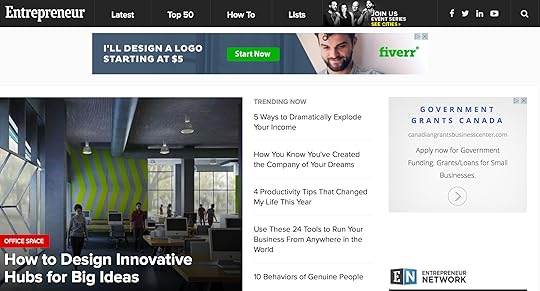
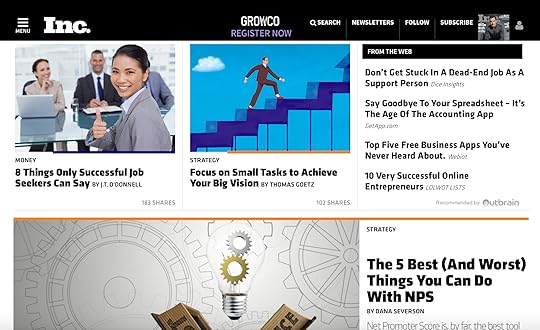
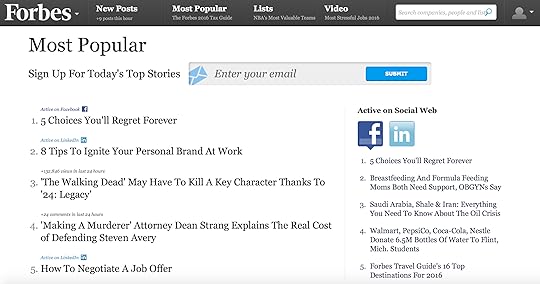
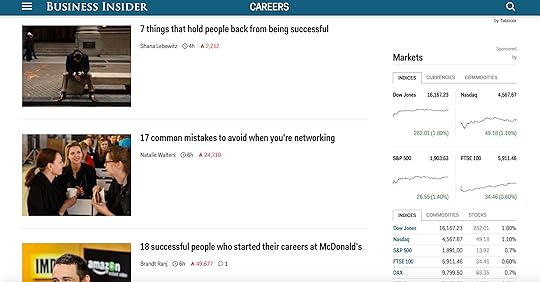

Dan's Related Posts:40% of the search traffic to danpontefract.com is because of the term…Instead of Inbox Zero, How About Outbox ZeroFuture of Work: Add Open Leadership, Enterprise 2.0, Connected Learning and MixFacebook Bullying: An Open Letter to Zuckerberg, Schrage & GolerIn 2015, Will I …
STRETCH Is An Excellent Book To Help You With Tomorrow’s Workplace
Oxford Dictionaries defines the word stretch as follows:
“To be made or be capable of being made longer or wider without tearing or breaking.”
I can think of no better word to describe how we might go about future proofing ourselves for tomorrow’s workplace.
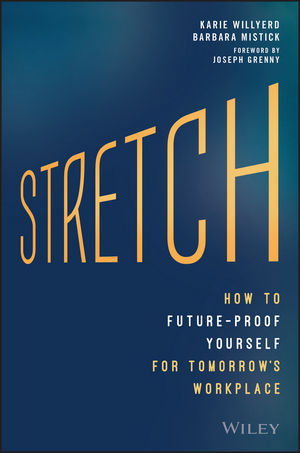 Indeed, the authors of the new book, STRETCH: How To Future Proof Yourself For Tomorrow’s Workplace, agree.
Indeed, the authors of the new book, STRETCH: How To Future Proof Yourself For Tomorrow’s Workplace, agree.
Authors Karie Willyerd and and Barbara Mistick want employees to stay relevant in their working lives. By introducing the concept of stretch, the authors have provided a compelling answer.
They urge us to, “Stretch how we learn, stretch to stay open in our thinking, stretch to build diverse networks and experiences, and stretch our motivation.” They do so not for vanity’s sake, rather to ensure employees do not become obsolete, research they unearthed that happens to be a large concern of ours as it relates to the future of work.
But the authors also warn us as well that to stretch takes hard work. There is no magic, silver bullet.
The book starts with three specific calls to action of sorts, surfacing from their research, surveys and synthesis. Think of them as themes that are constantly felt by employees. These themes make up a number of very helpful strategies and recommendations to make changes in one’s thinking, habits and workplace attitude. The authors refer to these themes (and accompanying actions) as “Stretch Imperatives”. They are:
It’s All On You (don’t be passive – take control of your situation, learn on the fly and be open)
You Need Options (one size definitely doesn’t fit all – build a diverse network and be greedy about experiences)
You Have Dreams (developing as a person, for the future – bounce forward)
Each of the aforementioned themes are sections in the book, each consisting of incredible (and real) stories to help the reader absorb the concepts.
In Section II (It’s All On You) my favorite tip had to do with the concept of unlearning. Ultimately, employees cannot remain steadfast in previous ways, and ought to be open to new ways of doing things. The authors, for example, admitted to the habit of putting in two spaces at the end of a sentence, for that is how they were taught. Rest assured, the book’s thousands of sentences only have one space at their conclusion.
Section III (You Need Options) explores several key practices to build a diverse network while introducing the importance of having vast experiences. As someone who believes that my network is my net worth, I fully subscribe to the author’s view that “The give and take of using people and helping people to advance our mutual goals is what makes a network come alive.” Through examples concerning two individuals (Zach and Kayla) the question that the authors raise, “Who wouldn’t want an interconnected group of people who can help us land jobs, find new business, solve a problem, or support us in times of crisis?” is categorically answered.
When it comes to being greedy about experiences, the authors rightfully suggest to “think strategically, both in terms of the number of experiences you’d like to acquire and the timeframe in which you hope to accomplish them.” As I have found in my career as both a Chief Learning Officer and an academic, those that take greedy initiative to experience more at work (and outside of it) end up not only happier, but they seem to do better financially, too. “Don’t just let experiences happen to you,” the authors continue, “but choose the experiences that benefit you the most.”
The final Stretch Imperative, (You Have Dreams) found in Section IV, is the focus of what the authors refer to as “bounce forward” – a key practice of people who have the ability to overcome even the most extreme hardships.
The authors discovered being able to bounce forward consists of three key traits:
Grit: perseverance and commitment (passion) for long-term goals
Resilience: ability to adapt and recover quickly from difficulties
Motivation: the drive to initiate and maintain goal-oriented behaviors
Sprinkling examples of “bounce forward” through the stories of people like Jill Abramson, Mario Capecchi, Alan Horn, Brian Action, James B. Stockdale, Brian Ray, John Gardner, and Steven Spielberg, the authors successfully help the reader understand how to stay motivated through the ups and downs of a career, providing strategies to remain focused on our dreams.
Another part of the book that I believe will help those trying to future proof for tomorrow’s workplace is the “Stretch Break” sections. Each contains a series of self-defining career questions as well as self-assessments, both provocative and helpful. Each section also contains a succinct but powerful summary.
Finally, Joseph Grenny, the New York Times bestselling author of Influencer and Crucial Conversations, wrote the foreword to Stretch. What I appreciated most was the following passage:
“Too many business books are authored by consultants who have never personally had a career in large organizations, started companies, led public institutions, or worked in non‐profits. Their guidance falls apart when it comes to the practical realities of everyday life.”
Indeed, it is the opinion of this reader (and early reviewer of the book) that Willyerd and Mistick have provided meaningful insights and practical, evidence based solutions. Stretch is not a book cooked up by consultants to act as a business card. Stretch is not a book ghost written to falsely proclaim superior knowledge on a particular subject matter area.
Stretch is a book that provides truthful, research-based solutions that will undoubtedly help you future proof for tomorrow’s workplace requirements. Emanating from two individuals who have between them two doctorates, multiple awards and decades of big-company, start-up and not-for-profit experience is what makes it that much more meaningful. It is a book I will be recommending to those in search of career answers for tomorrow’s workplace.
Dan's Related Posts:Three Types of Workplace MindsetsDear C-Suite: We Don’t Do Training AnymoreDear Mr. Machado – A Few Connected Learning Options for YouFavourite Books of 2013 That I ReadIf Your Enterprise Social Network Is A Ghost Town It’s Probably Due To Your…
January 21, 2016
Why I Teach
 The North is to South
The North is to South
What sand is to beach.
My life is my learning
And that’s why I teach.
Dan's Related Posts:Dear Mr. Pontefract – I Need a Connected Learning PlatformO Canada My CanadaThe Wolf Pack and LearningLooking Back on Four Decades: My Top 40 Learning MomentsKudos Jacques Godin, an Engaged Air Canada Employee
January 16, 2016
Rey & Finn of Star Wars Docked 40% On Year-End Performance Review
 With her eyes gazing over a table littered with papers, blue milk and holograms, General Leia Organa warned her team, “I’ve got a bad feeling about this.”
With her eyes gazing over a table littered with papers, blue milk and holograms, General Leia Organa warned her team, “I’ve got a bad feeling about this.”
It was time for the Rebellion’s annual calibration exercise. What joy! Performance management does in fact reach all corners of the Galaxy.
Unbeknownst to these Resistance fighters–up against the evils of Snoke, Kylo Ren and a seemingly infinite number of Stormtroopers–similar meetings were simultaneously being conducted by corporate leaders on a tiny outpost planet called Earth, located in the Milky Way system. Indeed the force awakens in a perennial fashion everywhere.
The same rules apply on Earth as it does on Jakku or Hoth or Rebel headquarters, where Leia and her direct reports were meeting.
Senior leaders of the organization (affiliated by one supreme vice-president or senior vice-president or evil Snoke-like chancellor of some regard) lock themselves in a room for a few hours and discuss employee performance from the past year. All of them come prepared to discuss the good and the bad of their team … as well as employees ‘not’ on their team. It’s an excellent opportunity to rip to shreds the performance of employees they never even come into contact with.
It’s called calibration.
In other words, it can be hierarchical, managerial blood sport. It happens once a year in many firms, including General Organa’s “Rebel scum.”
Many organization’s performance management process dictates that everyone in the organization needs an annual score. Even stars like Rey, Finn and Han have to be measured by leaders in the Rebellion.
How else would toy makers know whether to add them to the game of Monopoly or not? (Sorry Rey, maybe Episode VIII.)
If it weren’t for the performance management review process and the supreme leader calibration meeting, how would employees ever know their self-worth at work? Thank the swampy heavens of Dagobah that when the calibration meeting concludes, leaders are then free to have the annual “performance management review meeting” with the team member, blaming the calibration exercise for “lower than expected” scores.
So much for self-actualization let alone meaning and worth at work.
After all, this is the manner in which “performance” is managed. Right?
Calibration is how bonuses, promotions, even compensation adjustments come to be. It’s how leaders adjudicate merit. It’s how perquisites get distributed.
Tellingly, calibration is the organization’s chance to bash its employees “fairly” into an imaginary bell curve of performance. For many firms, any one team–regardless of its size–must ensure that at the end of the calibration meeting the average performance score for the entire team equals 100%. It’s simply the law of all galaxies.
Thankfully, smart Jedi like Josh Bersin of Deloitte have debunked such a model.
It matters not what one team or individual has tried to achieve. Do or do not, there is no performance management try.
The overall score of the team must equal 100%, performance or effort be damned.
 Back at the Rebel base in Leia’s calibration meeting, her direct reports–Admiral Ackbar, the ghost of Obi-Wan Kenobi, super smart Maz Kanata and, mistakenly, C3PO–were busy debating the recent performance of key members from the Resistance. We pick things up at the beginning of the third hour of deliberations for some insight into the art of calibrating.
Back at the Rebel base in Leia’s calibration meeting, her direct reports–Admiral Ackbar, the ghost of Obi-Wan Kenobi, super smart Maz Kanata and, mistakenly, C3PO–were busy debating the recent performance of key members from the Resistance. We pick things up at the beginning of the third hour of deliberations for some insight into the art of calibrating.
“What do you mean you have a bad feeling,” shrieked Ackbar, as he rather weirdly gazed one eye at Leia and the other at Kenobi’s ghost. “The fact of the matter is Skywalker did nothing for over two hours. Standing on a mountain overlooking a paradise-like body of water while we were busy trying to fend off Snoke’s army and a weapon of mass destruction is not deserving of a 100% rating. I say he gets 5%, tops. He didn’t even speak!”
“But sir, he did wake up Artoo,” replied Threepio, clumsily knocking over a glass of blue milk with his shiny red arm while excitedly trying to stick up for Master Luke.
Obi-Wan chimed in. “If Luke had not left in the first place, we would not be in this blasted predicament with the First Order.”
“But he’s my brother,” lamented Leia.
“Oh, so you’re playing favorites,” questioned Maz? “Look where that got you with your son, Ben. By the way, we don’t have to rank Ben–or is it Kylo now– this year do we? I still don’t think he deserved the 110% rating from last year. I mean look what happened. He took his bonus, bought a new cape and mask and joined that Snoke bloke. Crazy, but I told you it would happen. I warned you what he might eventually do to you or Han.”
 “Admiral Ackbar,” interrupted Obi-Wan, “I see you gave Han a 0% rating this year. Why?”
“Admiral Ackbar,” interrupted Obi-Wan, “I see you gave Han a 0% rating this year. Why?”
“Isn’t it obvious?” answered Ackbar while cleaning up Threepio’s blue milk mess.
“But he finished the year with us,” replied Leia. “He is entitled to his fair share. He did his job. He and Chewie brought down the deflector shield of Death Star 2.0. Let’s give his bonus to Chewie instead.”
“Do we even calibrate wookies,” asked Obi-Wan?
Becoming exasperated with the conversation, Ackbar yelled, “If Han deserves a fair share, I am dropping my rating of Finn from 90% down to 50%.”
“I have Finn at 200% as the odds of another Stormtrooper defecting to the Resistance are 6 and a half million to one” responded Threepio.
 Seconds later, Kanata reached over and switched Threepio off.
Seconds later, Kanata reached over and switched Threepio off.
“Finn might be a traitor, a liar, even a janitor,” countered Obi-Wan, “but his lightsaber skills were exquisite. I have Finn at 85%.”
“I’d sooner kiss a Tauntaun than give Finn anything more than 75% this year,” exclaimed Leia. “He’s unconscious anyway. He’ll never know what score we give him until 2017.”
“That’s wretched and unethical Leia,” said Obi-Wan, moving to sit on another ghost log.
“I guess there is a little bit of my father in me after all,” she retorted.
“What about Poe,” asked Kanata?
The room fell quiet. No one had any idea who that was.
“So, 100% for Poe,” continued Maz?
Everyone nodded in groupthink agreement.
“That brings us to Rey,” Ackbar mentioned as he rose from his seat to find something to eat at the live sushi bar.
Maz asked, “Does she have a last name, I can’t find her on my list?”
“I have her at 175% for she is the ‘chosen one,'” claimed Obi-Wan.
“You say that about anyone living on a sand planet Kenobi,” laughed Admiral Ackbar.
“I don’t really know her,” said Leia, “but she does hug well.”
“If what Chewie, BB-8 and Finn claim is true,” said Obi-Wan, “Rey handled herself with determination and resilience throughout several potentially dire situations. Were it not for her, at a minimum, we would not have the Millennium Falcon back.”
“What about Luke’s lightsaber, you know, the entire plot of this performance review related to Rey,” asked Maz?
 “Run Luke Run,” responded Obi-Wan.
“Run Luke Run,” responded Obi-Wan.
“Ok Ghost Obi-Wan, you are acting Tatooine crazy again. You are free to go now,” a fuming Leia answered with anger. “I think we are just about done here.”
Admiral Ackbar returned from the sushi bar. “Are we finished,” he asked? “Does it all average out to 100%?”
General Organa remarked, “Here’s the plan. Poe gets 100%, Han is at 200%, after all he is the most experienced. Finn drops to 60%, Luke gets 80% (just because) and that leaves 60% for Rey.”
“Is it fair,” asked Maz, “particularly for Rey?”
“It doesn’t matter,” replied Leia. “It averages to 100%. We can take care of Rey next year. She’ll be fine. She did get to fly the Millennium Falcon.”
Obi-Wan’s ghost reappeared in between Ackbar and Leia.
“Rey at 60% is preposterous. I won’t stand for it,” cried Kenobi.
“What’s done is done, Ben,” said Leia. “Now go arrange your one-on-one annual performance review meetings and inform everyone of their score.”
Back on the tiny colony known as Earth, the Society for Human Resource Management (SHRM) reports that only 5% of individuals who participate in performance management practices in any type of organization are satisfied with the process and the outcome. Sibson Consulting found similar results, indicating only 5 percent of respondents graded it with the highest level on a 5-point scale.
Rather ironically, the firm also found that almost 60 percent of all HR managers actually dislike their own performance management practices.
Globoforce, a Massachusetts-based consulting firm, found 51% of respondents believe the performance development process is not an accurate measure of the work they accomplish. Over half of all workers think the way in which they are being measured at work is hypocritical. Furthermore, team members are skeptical of the process itself. For example, 24% actually feared the annual review.
The question we must ask is whether the existing system of the performance management process is as advantageous as some claim.
Does it aid or hinder whether a team member will ever feel professional purpose in their role? Does the once-a-year “performance review” and the “calibration meeting” do anything to fuel a sense of organizational purpose?
Whether with central tendency—where everyone receives a rating that is average, placed in the middle of the bell curve—or through unreasonable performance standards that penalize team members who in fact achieve above the norm, the performance review could be one of the most loathed processes in any organization, whether public sector, not-for-profit or for-profit. The calibration meeting is no help either.
Any potential for intrinsic personal achievement, motivation or confidence becomes difficult for employees as a result of such archaic practices.
I wonder how Rey and Finn will feel when they are informed of their scores?
I wonder how some of those team members on Earth are going to feel over the next few weeks?
I wonder if our performance management and calibration practices will ever improve?
Kudos to organizations that have evolved, including the likes of General Electric, Microsoft, Adobe, PWC among others.
__________
Dan Pontefract is the author of FLAT ARMY: Creating a Connected and Engaged Organization and is Chief Envisioner at TELUS Transformation Office. His next book, THE PURPOSE EFFECT: Building Meaning in Yourself, Your Role and Your Organization, will publish May 10, 2016.
Dan's Related Posts:Stack Ranking the RobotsThe Star Wars Mentoring ProgramLessons In Culture From United AirlinesIs Your Corporate Culture The Root Cause Of Bad Meetings?“Oh, you’re one of those. You want to work anywhere, anytime.”
January 15, 2016
In Victim
 Joe-Maccer
Joe-MaccerEach day I sit cloaked in a fear,
‘They’ steal the light from everywhere.
Inveterate greed crystal clear,
My soul seeks those who choose to care.
Unhinged by the profit plasma
I wonder, ‘Is it time to cry?’
Ruthless are ‘they’, a blood villa:
Pernicious minds built to deny.
Prodigious pluckiness come to!
Despite ‘their’ entrenched and vile way
Hope springs meaning for me, for you
And we must act without delay.
Fear not new day, I am not late
To true purpose, love, life or role.
“I am the master of my fate:
I am the captain of my soul.”*
* With my utmost respect to William Ernest Henley.
Dan's Related Posts:We May Not AlwaysWhat Should The Title Of My Next Book Be?We Are All BostonLeisureCoaching Should Be An Expectation Of All Connected Leaders
December 31, 2015
What Is A Friend?
Willing.
In a moments notice, a friend is willing.
Willing to give.
Willing to forgive.
Willing to follow.
Willing to unfollow.
Willing to colour.
Willing to discolour.
Whose friend is willing, is a willing friend.
Dan's Related Posts:For Don …When Euan and Dan Keynote Together at #HRtecheuropeIFShould Companies Allow Facebook at Work?What I Learned About The Stigma Of My Stigma
December 28, 2015
Purpose: The Word of 2016
Several years ago I started an annual writing tradition that continues to this day. I think about a word that ought to reflect the coming year, and I pretentiously coin it the “Word of the Year.”
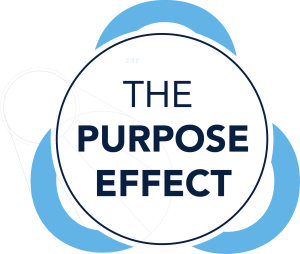 On May 10, 2016, I am set to release my second book, “The Purpose Effect: Building Meaning in Yourself, Your Role and Your Organization” and rather tellingly, my word of the year for 2016 is purpose.
On May 10, 2016, I am set to release my second book, “The Purpose Effect: Building Meaning in Yourself, Your Role and Your Organization” and rather tellingly, my word of the year for 2016 is purpose.
The etymology of purpose is interesting and perhaps important to understand first.
Circa 1300, the Old French word porpos and the Anglo-French word purpos combined with porposer to give us purpose. Whether as an “intention, aim and goal” or “to put forth,” purpose can denote a state of being—a noun—or it creates action as a transitive verb. There might be a purpose to attending a meeting or you may be seeking purpose in the meeting itself.
Put simply, there is a whole lotta purpose to purpose.
The new book, The Purpose Effect, details a three-way relationship between an individual’s personal sense of purpose in life, the organization’s purpose where they are employed and a person’s purpose in their actual role at work. When all three aspects of purpose are properly defined, are well aligned, and function in partnership with one another, then the employee, the organization and society mutually benefit. When they are not, it can lead to significant damage in society and in the organization. Of course it can lead to a whole lotta unfulfilled personal purpose, too. The Purpose Effect is the pattern I have exposed.
If an organization exhibits a high degree of purpose in its mission, objectives and actions—taking a stand to benefit society—there is a good possibility that employees will more easily demonstrate purpose in their roles at work, likely aiding and adding to their own personal sense of purpose in life as well. It is no coincidence that three entities—the organization, society and the employee—greatly benefits when this occurs.
If an individual joins an organization that is in direct conflict with their personal sense of purpose, there is a cogent likelihood they will develop a workplace mindset that is negative, ambivalent, even melancholic. If the role an individual performs provides the opportunity to demonstrate purpose—in alignment with both a personal sense of purpose and that of the organization—there is a very good chance of increased engagement, even fulfillment.
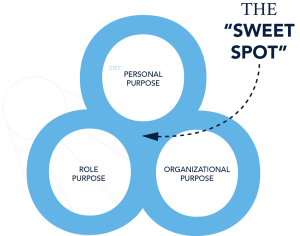 Think of purpose as a three-legged barstool. If one of the legs is broken or uneven, either an individual ends up crashing to the ground or there is a perpetual wobble, prompting a feeling of uneasiness, of disequilibrium. Such a lack of balance in the workplace can result in personal disengagement, disbandment of a team, or in the direst instance, the end of the organization itself.
Think of purpose as a three-legged barstool. If one of the legs is broken or uneven, either an individual ends up crashing to the ground or there is a perpetual wobble, prompting a feeling of uneasiness, of disequilibrium. Such a lack of balance in the workplace can result in personal disengagement, disbandment of a team, or in the direst instance, the end of the organization itself.
Those who lack direction in these situations, simply go through the motions, longing for the day when their opinions and ideas mattered, helpless as senior leaders pursue an organizational purpose that has no meaning for them personally. Any lack of alignment between the three categories of purpose—the barstool legs—can have devastating consequences at both an individual and a collective level.
It is amazing to witness—like being the recipient of a ‘pay it forward’ moment for the first time—what happens to your self-confidence when you go above and beyond the call of duty. It’s even more startling impressive how your life begins to flourish when you work extra hard to develop, define and decide your personal purpose. When the organization defines its purpose such that it agrees to serve and benefit all stakeholders—customers, employees, owners, community and the environment—and not just shareholders or power mongers, it becomes a canon of benevolence. When personal, organizational and role purpose become symbiotic, the pro’s outweigh the con’s time and time again.
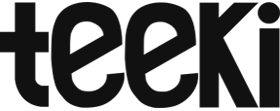 In 2010, Lindsay Hemric was appalled by the way in which many clothes manufacturers made their products. Sweatshops and environmentally unfriendly practices were the norm. Something had to be done. Lindsay founded Teeki, an activewear firm that does the unthinkable. It takes recycled water bottles, invokes an eco-friendly process that harnesses the fibres from the bottles to then create clothing such as hot pants, tank tops and bell bottoms Teeki commits to a purposeful organizational DNA, serving all stakeholders, while Lindsay has evidently achieved both role and personal purpose. Indeed, as Teeki’s corporate ethos suggests, the company dances to a different beat, stretches with the yogi, runs to the highest peak, and swims where the ocean becomes one, in its pursuit of putting purpose on par with profit.
In 2010, Lindsay Hemric was appalled by the way in which many clothes manufacturers made their products. Sweatshops and environmentally unfriendly practices were the norm. Something had to be done. Lindsay founded Teeki, an activewear firm that does the unthinkable. It takes recycled water bottles, invokes an eco-friendly process that harnesses the fibres from the bottles to then create clothing such as hot pants, tank tops and bell bottoms Teeki commits to a purposeful organizational DNA, serving all stakeholders, while Lindsay has evidently achieved both role and personal purpose. Indeed, as Teeki’s corporate ethos suggests, the company dances to a different beat, stretches with the yogi, runs to the highest peak, and swims where the ocean becomes one, in its pursuit of putting purpose on par with profit.
 Purpose can come when you set out to deliver “more” as well. Another example to highlight regarding a firm putting a greater purpose on par with profit is Uncharted Play. Founded by Jessica O. Matthews and Julia Silverman in 2011, Uncharted Play’s mission is to deliver motion-based, off-grid renewable energy (MORE) into “everything that moves.” The company has designed both a soccer ball (called the Soccket) and a jump rope (called the Pulse) that produce energy after a few hours of use. Tellingly, the company believes that the concept of play can be used to prove that:
Purpose can come when you set out to deliver “more” as well. Another example to highlight regarding a firm putting a greater purpose on par with profit is Uncharted Play. Founded by Jessica O. Matthews and Julia Silverman in 2011, Uncharted Play’s mission is to deliver motion-based, off-grid renewable energy (MORE) into “everything that moves.” The company has designed both a soccer ball (called the Soccket) and a jump rope (called the Pulse) that produce energy after a few hours of use. Tellingly, the company believes that the concept of play can be used to prove that:
Doing good doesn’t need to be boring.
Anyone, anywhere can be a social inventor.
If people across the globe can connect and work together to address the issues facing humanity, the future is boundless.
Both Teeki and Uncharted Play (and its purpose-first founders) not only are aligning personal, organizational and role purpose, they are committed to ensuring all stakeholders are being served.
But there are several warning signs related to defining and maintaining purpose, whether personally or organizationally. Many believe achieving purpose in life and at work is something that magically appears, like an epic Cirque du Soleil trick. Others mistakenly argue the concept of purpose is actually owed to them by their boss or organization. Some in senior leadership roles scoff at the thought of an organization delivering a higher sense of purpose to aid society. After all, profit is far more advantageous than purpose, right? Purpose never helped anyone climb the career ladder, did it?
Nothing could be further from the truth.
Purpose does not fall out of the sky.
Purpose is not found in a fortune cookie.
Purpose cannot surface from a wishing well.
Purpose is not owed to anyone.
Purpose will never manifest at a casino roulette table.
Purpose is not an imaginary friend.
Purpose does not harm society.
Purpose does not stunt your career.
Purpose does not spell the end of profits.
Purpose is a verb and a noun. Purpose is for you and the organization. Purpose has a purpose. Purpose is for you, me and everyone else.
In his posthumous 2004 book, Pathways to Bliss, Joseph Campbell provides us with another thought regarding purpose:
What I think is that a good life is one hero journey after another. Over and over again, you are called to the realm of adventure, you are called to new horizons. Each time, there is the same problem: do I dare? And then if you do dare, the dangers are there, and the help also, and the fulfillment or the fiasco. There’s always the possibility of a fiasco. But there’s also the possibility of bliss. (Joseph Campbell, Pathways to Bliss, 2004. New World Library)
Purpose . . . it is a word that offers the “possibility of bliss.” While purpose in the workplace is imperative, leaders are potentially overlooking its significance to the overarching health of our civilization. My experience and research suggest purpose ought to be the objective, but it is the misalignment of the personal, role and organizational categories of purpose that ensure the journey toward purpose never begins.
This is why “purpose” is my word for 2016.
More to come on May 10, 2016 with the release of The Purpose Effect. I hope you have the chance (and want to) pick up a copy for you and/or members of your team.
Dan's Related Posts:My TEDx Talk on The Purpose EffectPerhaps the Purpose of an Organization?What Should The Title Of My Next Book Be?My PurposeMy Definition of Work and an Update on Book Two
December 23, 2015
Thank You 2015
In 2015, I celebrated 20 years of a truly wonderful marriage. Some people struggle to find 20 consecutive days of blissful matrimony.
In 2015, I watched our goats turn 12-, 10- and 8-years old. Some parents are tragically forced to say goodbye to an offspring far too early.
In 2015, I wrote a 93,000 word book, scrapped it, and then wrote another book consisting of 70,000 words. Some writers never get the chance to receive feedback and guidance like I did to make the end result far better.
In 2015, I traveled >100,000 miles on an airplane visiting places such as the Great Barrier Reef, La Jolla, Copenhagen, Regina, Cambridge/Oxford and Montreal. Some people never have the chance to leave their own city.
In 2015, I was given the chance to share my thoughts on a stage over 50 times to audiences across three different continents, including another TED. Some people are never asked to speak once, but have far better ideas than me.
In 2015, I ate three well-balanced meals every day of the year. There are far too many in the world who do not enjoy such a luxury.
In 2015, I suffered no major ailments or health related issue. But, there are many within my own networks that did.
In 2015, I had the opportunity to interact with hundreds of professionals and people, learning about new ideas, concepts and knowledge. Many people do not possess such a way of life.
Thank you 2015, for I am a very lucky man.
Dan's Related Posts:In 2015, Will I …To The EstablishmentThe Black Friday Shopping FlowchartMy TEDx Talk on The Purpose EffectCalling Frederic Laloux Of Reinventing Organizations

